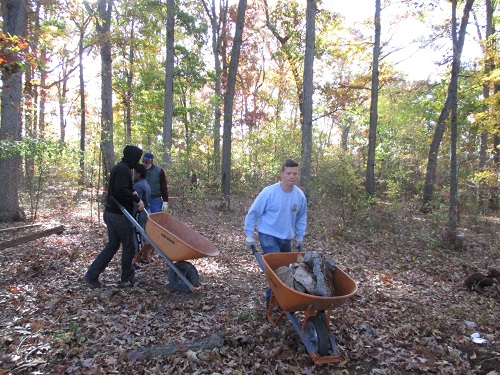
November was a busy month for forest patches! Baltimore Green Space and three of its forest patches teamed up with the co-ed service fraternity Alpha Phi Omega of Johns Hopkins University for a vine removal, a planting, and a “trash harvest.” In all, 36 volunteers removed 46 bags of vines and trash, planted 10 native plants, freed 20 trees from vines, and hauled a small hill of concrete.
Fairwood Forest is a 4-acre woods near Belair Road, where residents tell stories of gathering arrowheads as children. On a blustery November morning, Desiree Shelley shouted over the wind roaring through the trees. Desiree, who runs the TreeBaltimore Weed Warriors program, made her lesson on invasive removal quick so that the volunteers could get moving and stay warm. Eleven people – 3 forest stewards and 8 residents and students – removed 22 bags of kudzu and English ivy from Fairwood Forest, in addition to a pile of debris that included old tires, chairs, wood, and a Big Wheel. Forest Stewards Daisy Sudano Pellegrini and Jim Pellegrini rewarded all of the volunteers with hot pizza, gratefully eaten in the roaring wind.
Why do all that work? Vines can grow quickly, covering the forest floor, climbing tree trunks, and covering the tree canopy. Because vines don’t grow a structure that will bear their own weight, they can put more energy into growth. The result? They can topple or smother the native trees that make up the forest, and outcompete plants that grow close to the ground, all without doing a good job of feeding wildlife. Not all vines are harmful – but fast-growing vines from other parts of the world, such as kudzu and English ivy, can certainly disrupt a forest patch.
Some forest stewards plant native plants on the forest floor as they remove invasives. At N.M.N. Urban forest patch, a tiny triangle wedged between 3 alleys, our summer research showed that all the trees are native. However, many are in danger because English ivy has climbed almost to the top of the trees. The students made it their mission to remove vines. They also planted 20 native flowers and shrubs along the edge. Plants were provided at a discount by the locally owned Green Fields Nursery.
Finally, at HEPP Park in Hamilton Hills,the students and residents made a hearty “trash harvest.” HEPP Park is a 4-acre forest that boasts native plants from its canopy trees to the shrubs and groundcovers. What do you do when a contractor dumps a substantial amount of concrete in the woods? You report it to 311 as an environmental crime – and then you follow up. Much of the concrete was hauled away by the Department of Public Works with its big machines. We were so grateful for DPW’s help, but the machines couldn’t reach every last piece, and also did a little damage to the forest floor. So we scheduled a work day.
Forest Stewards, students, residents, and incoming City Council member Ryan Dorsey worked for hours to remove concrete boulders and dust, other dumped debris, and much wind-blown litter. They also smoothed out the soil that had been disturbed. In the afternoon, Mia Blom, the lead Forest Steward, planted trees with at the edge of the forest patch with the local Cub Scout troop. We are all rooting for the young sassafras and sweet gum trees! Ryan Dorsey connected us to the Local Chapter 7 of the Laborers’ International Union of America, which hauled away the trash and debris.
Many thanks to all our Forest Stewards, the Hamilton Hill Neighborhood Association, DPW, the Laborers’ International Union of America, the Cub Scouts, TreeBaltimore, Ryan Dorsey, Weed Warriors, Green Fields, and last but not least the Alpha Phi Omega service fraternity for helping Baltimore’s forests stay healthy.
Be the first to hear about exciting events, news, and opportunities.
[email protected]
(813) 530-8166
2100 Liberty Heights Avenue
Baltimore MD 21217
Facebook | Instagram | Twitter